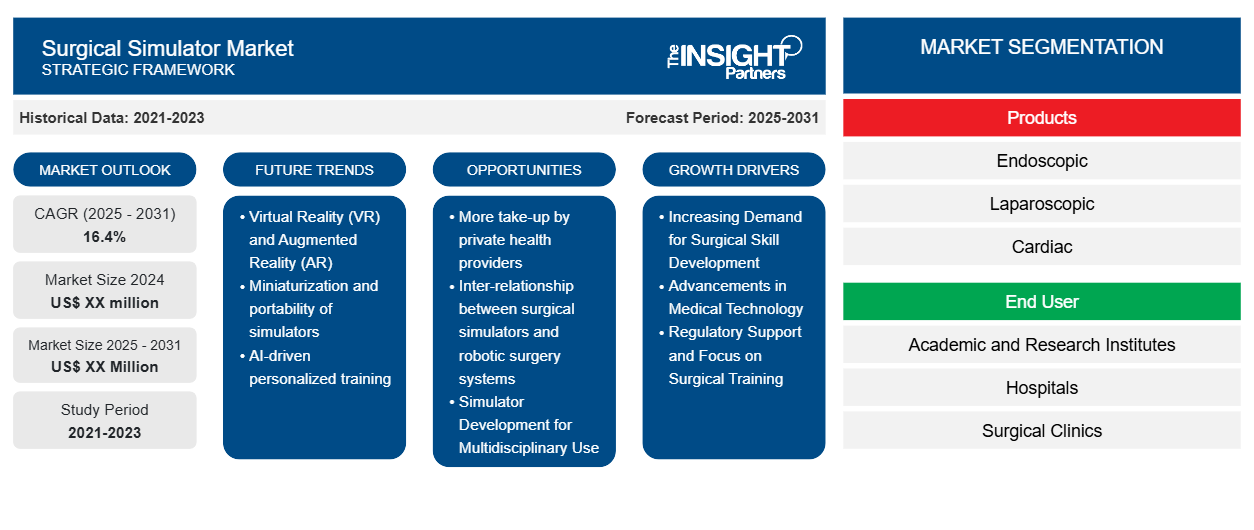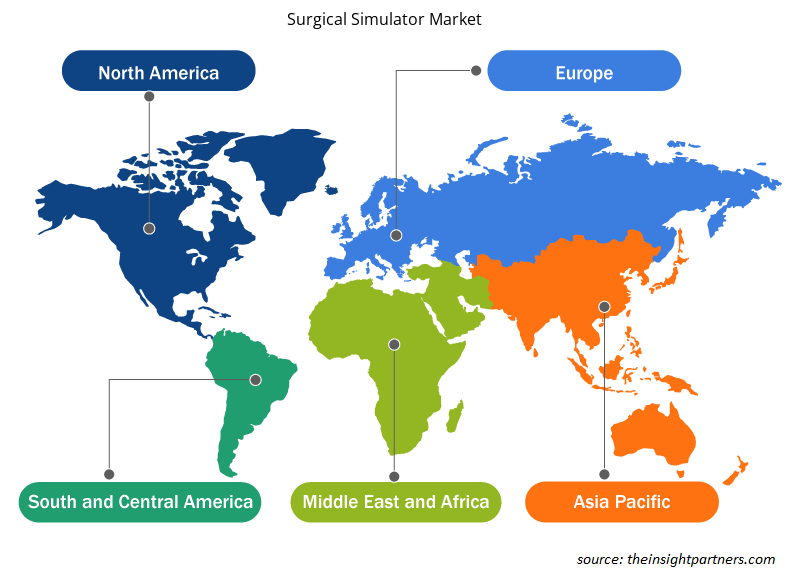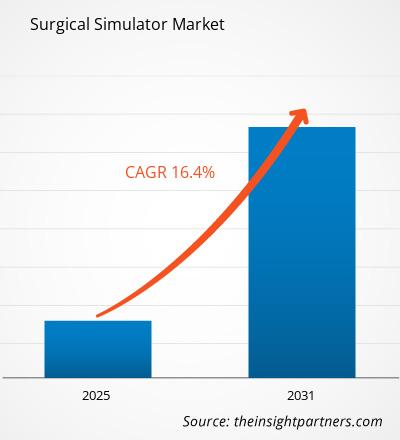The Surgical Simulator Market is expected to register a CAGR of 16.4% from 2025 to 2031, with a market size expanding from US$ XX million in 2024 to US$ XX Million by 2031.
The report is segmented by Products (Endoscopic, Laparoscopic, Cardiac, Gynecological, Arthroscopic, Neurological). The report further presents analysis based on the End User (Academic and Research Institutes, Hospitals, Surgical Clinics). The global analysis is further broken-down at regional level and major countries. The Report Offers the Value in USD for the above analysis and segments.
Purpose of the Report
The report Surgical Simulator Market by The Insight Partners aims to describe the present landscape and future growth, top driving factors, challenges, and opportunities. This will provide insights to various business stakeholders, such as:
- Technology Providers/Manufacturers: To understand the evolving market dynamics and know the potential growth opportunities, enabling them to make informed strategic decisions.
- Investors: To conduct a comprehensive trend analysis regarding the market growth rate, market financial projections, and opportunities that exist across the value chain.
- Regulatory bodies: To regulate policies and police activities in the market with the aim of minimizing abuse, preserving investor trust and confidence, and upholding the integrity and stability of the market.
Surgical Simulator Market SegmentationProducts - Endoscopic
- Laparoscopic
- Cardiac
- Gynecological
- Arthroscopic
- Neurological
End User - Academic and Research Institutes
- Hospitals
- Surgical Clinics
- Endoscopic
- Laparoscopic
- Cardiac
- Gynecological
- Arthroscopic
- Neurological
End User - Academic and Research Institutes
- Hospitals
- Surgical Clinics
Customize This Report To Suit Your Requirement
You will get customization on any report - free of charge - including parts of this report, or country-level analysis, Excel Data pack, as well as avail great offers and discounts for start-ups & universities
Surgical Simulator Market: Strategic Insights

- Get Top Key Market Trends of this report.This FREE sample will include data analysis, ranging from market trends to estimates and forecasts.
Surgical Simulator Market Growth Drivers- Increasing Demand for Surgical Skill Development: The skills of healthcare professionals are now accentuating a growing concern for patient safety. Traditional methods of surgical training through cadaver-based or live surgery are becoming less viable. Fewer and fewer, these are often considered unethical, costly, and scarce sources. Thus, the surgical simulators are considered safer and more accessible. These simulators provide a hands-on experience to practicing professionals in the health sector, allowing them to train in controlled risk-free environments. This ability to operate and repeat procedures without the consequences of human error led to an ever-increasing demand for these simulators.
- Advancements in Medical Technology: Advances in virtual reality, augmented reality, artificial intelligence, and haptic feedback-based medical technologies are expected to surge further, resulting in increasingly complex surgical simulators, accordingly, improving the capabilities of these simulators. This will mean an increase in training effectiveness and experience for learners while using such simulators, fueled by such rapidly advancing technologies in the near future.
- Regulatory Support and Focus on Surgical Training: There is an increasing acknowledgment by governments across the world as well as healthcare institutions toward the significance of sophisticated surgical education and training programs. Nowadays, in most jurisdictions, statutory agencies insist that healthcare professionals undergo simulation training to enhance their clinical competencies. Owing to this trend, more medical schools, teaching hospitals, and healthcare centers are embracing surgical simulators. Also, rising government expenditures on health care education and professional training are further boosting the demand for these products.
Surgical Simulator Market Future Trends- Virtual Reality (VR) and Augmented Reality (AR): They revolutionize surgery simulation with the VR, offering trainees experience in a 3D environment where they could practice the complex surgeries highly interactively and realistically. On the other hand, the AR technology overlays digital information on the real-world environment so that surgeons can view critical structures in a real-time during procedure. They not only enhance the realism of training simulations but also allow for real-time feedback and performance tracking.
- Miniaturization and portability of simulators: Surgical simulators are big, costly, and typically used in a training laboratory or a medical school. I think the current trend drives toward more portable, compact simulators that may be used in many different settings-from home or remote locations. Portable devices make training much more accessible to professionals who do not have the kind of resources or proximity to large medical institutions. With portable simulators, training and further perfecting of skills can take place outside of strictly educational settings.
- AI-driven personalized training: AI is more increasingly used for making surgical simulations more realistic and efficient. AI-driven simulators could process the real-time performance of a surgeon to identify errors and propose corresponding corrections. In this regard, learners could learn at their own pace, so, for example, they would acquire very complicated procedures until they were transferred to actual surgeries. AI can also be used in creating more dynamic and adaptive simulation environments where the simulator responds according to the skill level of the learner.
Surgical Simulator Market Opportunities- More take-up by private health providers: Private health care providers, except for a few medical schools and some hospitals, are now beginning to open their eyes to the possibility of utilizing surgical simulators for training of their staff. Simulators are increasingly being adopted in private clinics and surgical centers to continually train their medical teams and thus improve their competence and minimize surgical error occurrences. This is a new source of revenue for manufacturers of surgical simulators.
- Inter-relationship between surgical simulators and robotic surgery systems: With the increasing usage of robotic-assisted surgeries, it is now feasible to integrate surgical simulators into the robotic systems. This would make it possible for trainees to have a virtual environment to practice their robotic surgeries, making them more familiar with the technology before performing actual live surgeries. Such a venture could be a good one for business for both the simulator manufacturing companies and the companies that produce robotic surgeries.
- Simulator Development for Multidisciplinary Use: It is a growing demand for multispecialty simulators-addressing the needs of multiple surgical specialties. And this opportunity lies right in front of the manufacturers: an all-in-one simulator allowing training across various domains-the neuro, the ortho, and the cardiovascular surgery. The companies can design flexible, modular simulators, making them cater to a much wider spectrum of clients: general hospitals, specialized medical centers, and academic institutions.
- Virtual Reality (VR) and Augmented Reality (AR): They revolutionize surgery simulation with the VR, offering trainees experience in a 3D environment where they could practice the complex surgeries highly interactively and realistically. On the other hand, the AR technology overlays digital information on the real-world environment so that surgeons can view critical structures in a real-time during procedure. They not only enhance the realism of training simulations but also allow for real-time feedback and performance tracking.
- Miniaturization and portability of simulators: Surgical simulators are big, costly, and typically used in a training laboratory or a medical school. I think the current trend drives toward more portable, compact simulators that may be used in many different settings-from home or remote locations. Portable devices make training much more accessible to professionals who do not have the kind of resources or proximity to large medical institutions. With portable simulators, training and further perfecting of skills can take place outside of strictly educational settings.
- AI-driven personalized training: AI is more increasingly used for making surgical simulations more realistic and efficient. AI-driven simulators could process the real-time performance of a surgeon to identify errors and propose corresponding corrections. In this regard, learners could learn at their own pace, so, for example, they would acquire very complicated procedures until they were transferred to actual surgeries. AI can also be used in creating more dynamic and adaptive simulation environments where the simulator responds according to the skill level of the learner.
Surgical Simulator Market Opportunities- More take-up by private health providers: Private health care providers, except for a few medical schools and some hospitals, are now beginning to open their eyes to the possibility of utilizing surgical simulators for training of their staff. Simulators are increasingly being adopted in private clinics and surgical centers to continually train their medical teams and thus improve their competence and minimize surgical error occurrences. This is a new source of revenue for manufacturers of surgical simulators.
- Inter-relationship between surgical simulators and robotic surgery systems: With the increasing usage of robotic-assisted surgeries, it is now feasible to integrate surgical simulators into the robotic systems. This would make it possible for trainees to have a virtual environment to practice their robotic surgeries, making them more familiar with the technology before performing actual live surgeries. Such a venture could be a good one for business for both the simulator manufacturing companies and the companies that produce robotic surgeries.
- Simulator Development for Multidisciplinary Use: It is a growing demand for multispecialty simulators-addressing the needs of multiple surgical specialties. And this opportunity lies right in front of the manufacturers: an all-in-one simulator allowing training across various domains-the neuro, the ortho, and the cardiovascular surgery. The companies can design flexible, modular simulators, making them cater to a much wider spectrum of clients: general hospitals, specialized medical centers, and academic institutions.
Surgical Simulator Market Regional Insights
The regional trends and factors influencing the Surgical Simulator Market throughout the forecast period have been thoroughly explained by the analysts at Insight Partners. This section also discusses Surgical Simulator Market segments and geography across North America, Europe, Asia Pacific, Middle East and Africa, and South and Central America.

- Get the Regional Specific Data for Surgical Simulator Market
Surgical Simulator Market Report Scope
| Report Attribute | Details |
|---|---|
| Market size in 2024 | US$ XX million |
| Market Size by 2031 | US$ XX Million |
| Global CAGR (2025 - 2031) | 16.4% |
| Historical Data | 2021-2023 |
| Forecast period | 2025-2031 |
| Segments Covered |
By Products
|
| Regions and Countries Covered | North America
|
| Market leaders and key company profiles |
Surgical Simulator Market Players Density: Understanding Its Impact on Business Dynamics
The Surgical Simulator Market market is growing rapidly, driven by increasing end-user demand due to factors such as evolving consumer preferences, technological advancements, and greater awareness of the product's benefits. As demand rises, businesses are expanding their offerings, innovating to meet consumer needs, and capitalizing on emerging trends, which further fuels market growth.
Market players density refers to the distribution of firms or companies operating within a particular market or industry. It indicates how many competitors (market players) are present in a given market space relative to its size or total market value.
Major Companies operating in the Surgical Simulator Market are:
- CAE Inc.
- Mentice AB
- 3D Systems Corporation
- Simulab Corporation
- Limbs and Things Ltd
Disclaimer: The companies listed above are not ranked in any particular order.

- Get the Surgical Simulator Market top key players overview
Key Selling Points- Comprehensive Coverage: The report comprehensively covers the analysis of products, services, types, and end users of the Surgical Simulator Market, providing a holistic landscape.
- Expert Analysis: The report is compiled based on the in-depth understanding of industry experts and analysts.
- Up-to-date Information: The report assures business relevance due to its coverage of recent information and data trends.
- Customization Options: This report can be customized to cater to specific client requirements and suit the business strategies aptly.
The research report on the Surgical Simulator Market can, therefore, help spearhead the trail of decoding and understanding the industry scenario and growth prospects. Although there can be a few valid concerns, the overall benefits of this report tend to outweigh the disadvantages.
Frequently Asked Questions
What is the expected CAGR of the Surgical Simulator Market?
The Surgical Simulator Market is estimated to witness a CAGR of 16.4% from 2023 to 2031
What are the driving factors impacting the Surgical Simulator market?
The major factors driving the Surgical Simulator market are:
1. Increasing Demand for Surgical Skill Development
2. Advancements in Medical Technology
What are the factor that act as a opportunity for market growth?
Virtual Reality (VR) and Augmented Reality (AR) act as a opportunity for growth of the market in forecast period.
Which region dominated the Surgical Simulator market in 2023?
North America region dominated the Surgical Simulator market in 2023.
Which are some of the players operating in the Surgical Simulator market?
Players operating in the market are CAE Inc, Mentice AB, 3D Systems Corporation, Stimulab Corporation, Limbs and Things Ltd, MEDICAL-X, Voxel-Man, VirtaMed AG, 3-Dmed, Surgical Science Sweden AB
Which segment accounts for highest revenue by products in 2023?
Endoscopic segment, by products, dominated the market in 2023.
- Historical Analysis (2 Years), Base Year, Forecast (7 Years) with CAGR
- PEST and SWOT Analysis
- Market Size Value / Volume - Global, Regional, Country
- Industry and Competitive Landscape
- Excel Dataset
Testimonials
Reason to Buy
- Informed Decision-Making
- Understanding Market Dynamics
- Competitive Analysis
- Identifying Emerging Markets
- Customer Insights
- Market Forecasts
- Risk Mitigation
- Boosting Operational Efficiency
- Strategic Planning
- Investment Justification
- Tracking Industry Innovations
- Aligning with Regulatory Trends
Yes! We provide a free sample of the report, which includes Report Scope (Table of Contents), report structure, and selected insights to help you assess the value of the full report. Please click on the "Download Sample" button or contact us to receive your copy.
Absolutely — analyst assistance is part of the package. You can connect with our analyst post-purchase to clarify report insights, methodology or discuss how the findings apply to your business needs.
Once your order is successfully placed, you will receive a confirmation email along with your invoice.
• For published reports: You’ll receive access to the report within 4–6 working hours via a secured email sent to your email.
• For upcoming reports: Your order will be recorded as a pre-booking. Our team will share the estimated release date and keep you informed of any updates. As soon as the report is published, it will be delivered to your registered email.
We offer customization options to align the report with your specific objectives. Whether you need deeper insights into a particular region, industry segment, competitor analysis, or data cut, our research team can tailor the report accordingly. Please share your requirements with us, and we’ll be happy to provide a customized proposal or scope.
The report is available in either PDF format or as an Excel dataset, depending on the license you choose.
The PDF version provides the full analysis and visuals in a ready-to-read format. The Excel dataset includes all underlying data tables for easy manipulation and further analysis.
Please review the license options at checkout or contact us to confirm which formats are included with your purchase.
Our payment process is fully secure and PCI-DSS compliant.
We use trusted and encrypted payment gateways to ensure that all transactions are protected with industry-standard SSL encryption. Your payment details are never stored on our servers and are handled securely by certified third-party processors.
You can make your purchase with confidence, knowing your personal and financial information is safe with us.
Yes, we do offer special pricing for bulk purchases.
If you're interested in purchasing multiple reports, we’re happy to provide a customized bundle offer or volume-based discount tailored to your needs. Please contact our sales team with the list of reports you’re considering, and we’ll share a personalized quote.
Yes, absolutely.
Our team is available to help you make an informed decision. Whether you have questions about the report’s scope, methodology, customization options, or which license suits you best, we’re here to assist. Please reach out to us at sales@theinsightpartners.com, and one of our representatives will get in touch promptly.
Yes, a billing invoice will be automatically generated and sent to your registered email upon successful completion of your purchase.
If you need the invoice in a specific format or require additional details (such as company name, GST, or VAT information), feel free to contact us, and we’ll be happy to assist.
Yes, certainly.
If you encounter any difficulties accessing or receiving your report, our support team is ready to assist you. Simply reach out to us via email or live chat with your order information, and we’ll ensure the issue is resolved quickly so you can access your report without interruption.















1. CAE Inc.
2. Mentice AB
3. 3D Systems Corporation
4. Simulab Corporation
5. Limbs and Things Ltd
6. MEDICAL-X
7. Voxel-Man
8. VirtaMed AG
9. 3-Dmed
10. Surgical Science Sweden AB






 Get Free Sample For
Get Free Sample For